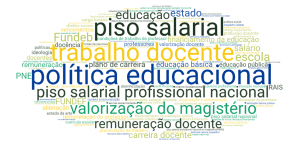REVIEW ARTICLE
CARVALHO, Suelen [1], FECURY, Amanda Alves [2], DENDASCK, Carla Viana [3], OLIVEIRA, Euzébio de [4], DIAS, Claudio Alberto Gellis de Mattos [5]
CARVALHO, Suelen. et al. Professional education in state schools in Brazil, North and Amapá, between 2012 and 2022: a brief review. Revista Científica Multidisciplinar Núcleo do Conhecimento. Year. 07, Ed. 12, Vol. 03, pp. 99-120. December 2022. ISSN: 2448-0959, Access link: https://www.nucleodoconhecimento.com.br/education/professional-education, DOI: 10.32749/nucleodoconhecimento.com.br/education/professional-education
ABSTRACT
Brazilian state governments are responsible for providing secondary public education, both formal and EPT. The federal government, however, is the main regulator of public policies in education, through the Ministry of Education and Culture (MEC)[6]. The objective was to carry out a bibliographic review on professional education in state schools in Brazil, in the North and in Amapá, between 2012 and 2022. It was carried out in research databases such as Google Scholar, Periodicals CAPES, Mendeley – Reference Management Software, and Scientific Electronic Library Online – SciELO, between 2012 and 2022. Using the selected descriptors, 52,854 scientific documents were found, of which 11 met the requirements and are part of this review. The Federal Government invested in the expansion and expansion of the EPT and most Brazilian states requested this technical and financial assistance. Efficient supervision of financial resources transferred to states is almost non-existent. This implies discontinuing actions aimed at strengthening, expanding and expanding EPT in the states and updating data by the State Departments of Education in the National Information System for Professional and Technological Education (SISTEC). EPT goes beyond education for marketing purposes. In the state network it needs to be public, polytechnic and of quality. It is necessary to have and carry out more studies and surveys in order to have a greater number of consolidated data about it, and thus increase the understanding of what EPT is like in state education networks in the country.
Keywords: EPT, State School, Amapá, Professional Education.
INTRODUCTION
Education has several concepts and meanings. Formal education, for example, takes place within the school through the relationship between the student and the teacher. It is in this place where the student learns the content explained by the teacher. This results in a certification document recognized by society, which is necessary to perform some jobs (LIBÂNEO, 2010).
Vocational Education is a modality of teaching basic education (primary and secondary education). The offer is carried out through technical courses and also Initial and Continuing Training (FIC)[8], which aim to develop skills and abilities to provide qualified labor for the job market. This type of education can be a facilitator for obtaining a job opportunity, maintenance, or replacement in the labor market, as well as for insertion in society (REGO et al., 2021).
The Federal Constitution states, in its articles 205 and 206, that:
A educação, direito de todos e dever do Estado e da família, será promovida e incentivada com a colaboração da sociedade, visando ao pleno desenvolvimento da pessoa, seu preparo para o exercício da cidadania e sua qualificação para o trabalho. O ensino será ministrado com base nos seguintes princípios: […] IV – gratuidade do ensino público em estabelecimentos oficiais (BRASIL, 1988).
As a duty of the State, governments must offer public and quality education free of charge to all citizens (BRASIL, 1988). In this scenario, public schools of the state education network emerge, which receive funding and investment from the Brazilian states. The obligation of states with education encompasses elementary school I and II, high school and some technical schools (BRASIL, 1996).
On October 26, 2011, the Federal Government, through Law 12,513, created the National Program for Access to Technical Education and Employment (PRONATEC)[9]. Among the objectives are the expansion of professional education in the federal and state networks and the expansion of professional courses (SOUZA, 2020).
The same law, in its 4th article, states that “[…] Pronatec will be developed through the following actions, without prejudice to others: […] II – fostering the expansion of vacancies and the expansion of state networks of professional education” (BRASIL, 2011).
For the expansion of state professional education networks, PRONATEC adopted, among others, public policy actions for Professional and Technological Education (EPT)[10] such as, for example, the Brasil Profissionalizado and Mediotec programs (MEC, 2018).
The Brasil Profissionalizado program, through financial assistance to the States, aims to expand, expand and modernize the schools of the state networks of professional and technological education, making the offer of technical courses of secondary level more accessible (SILVA et al., 2015; MEC, 2018b).
The Mediotec program offers vocational courses along with high school training with the aim of expanding and democratizing access to and training in EPT (MEC, 2018a).
Brazilian state governments are responsible for providing secondary public education, both formal and EPT. The federal government, however, is the main regulator of public policies in education, through the Ministry of Education and Culture (MEC) (VIANA and CASTIONI, 2017). For this, the MEC, through the Secretariat of Professional and Technological Education (SETEC)[11], prepared the National Catalog of Technical Courses (CNCT)[12]. This serves as a basis for planning course offerings by high-level technical professional education teaching institutions (MEC, 2022).
The CNTC is updated periodically and, as of 2020, is in its 4th edition. It presents 13 technological axes, divided into 215 courses, to offer professional courses for education networks (Table 1) (MEC, 2022).
Table 1 Shows the number of technical courses within the technological axes present in the National Catalog of Technical Courses (CNCT)
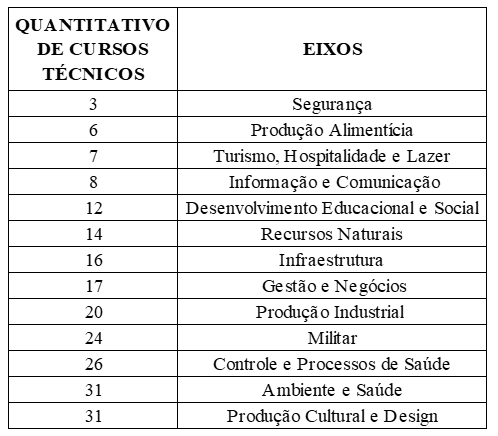
SETEC also prepared the Pronatec Guide for FIC courses, which is a guiding document for choosing courses, which is in its 4th edition (approved by Ordinance No. 12 of May 3, 2016). Contains 12 technological axes divided into 646 courses. (Chart 2) (MEC, 2016).
Table 2 Shows the number of technical courses within the technological axes present in the Pronatec Guide to FIC Courses
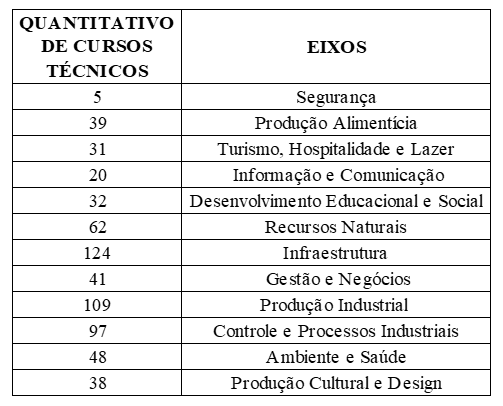
The National Information System on Professional and Technological Education (SISTEC), created in 2009 by SETEC, has the function of disseminating data on Professional and Technological Education in Brazil. Educational institutions that offer EPT need to enter data (the number of enrolled students, courses offered, class attendance and the number of graduating students) so that this system can have reliable indicators about Brazilian EPT. Through SISTEC, it is also possible to validate the diplomas of technical and professional courses (MACHADO, 2019).
In the state education network of Amapá, northern Brazil, it is possible to find out, via SISTEC, the number of schools that offer (or offered) places in the EPT area (Table 3).
Chart 3 Shows the number of state schools in Amapá that offer (or offered) places in the EPT area, according to SISTEC
| QUANTITATIVE OF
STATE SCHOOLS OF AMAPÁ |
QUANTITY OF
SCHOOLS THAT STILL OFFER CLASSES IN EPT |
MUNICIPALITIES OF THE STATE OF AMAPÁ |
| 1 | no offer | Laranjal do Jari |
| 10 | 4 still offering | Macapá |
| 2 | no offer | Mazagão |
| 1 | no offer | Oiapoque |
| 1 | no offer | Pedra Branca |
| 4 | 2 still offering | Santana |
Source: SISTEC (2022).
In October 2019, SETEC launched the New Paths Program, which aims to increase the offer of FIC courses (and professional qualification), investments in construction (renovations and expansions of state schools that offer EPT courses), and improvement in the quality of secondary education. The goal is to increase, by 2023, the number of enrollments in professional technical courses by 80% (MEC, 2021; IFSULDEMINAS, 2022; SOUZA, 2022).
In Amapá, the Novos Caminhos program started in 2021, with the launch of Public Notice 01/2021 with openings for Technical courses and FIC courses (SEED, 2021).
Professional education aims to train students beyond the labor market, using an omnilateral education, that is, educating for life; in training based on values and attitudes, ethics and morals, within society. Students, then, are formed as critical and creative subjects, being part of the construction of an emancipating education (VIANA et al., 2020).
OBJECTIVE
Conduct a bibliographical review on professional education in state schools in Brazil, in the North and in Amapá, between 2012 and 2022.
METHOD
A bibliographic review was carried out on professional education in state schools in Brazil, in Portuguese, in research databases such as Google Scholar, Periódicos CAPES, Mendeley – Reference Management Software, and Scientific Electronic Library Online – SciELO, between 2012 and 2022. For this, the keywords (or descriptors) “Professional education and state schools”, “ETEC in Brazil”, “State education and professional education”, “State schools and professional education”, “Professional education in the state network” were used. This allows the review to be based on the most up-to-date academic productions (CAPES, 2012).
Articles with content that combined professional education in state schools in Brazil with education, teaching and/or Professional and Technological Education (EPT) were used as inclusion criteria, within the review period. Articles that did not meet this content and/or period were excluded.
RESULTS AND DISCUSSION
Chart 4 shows the number of articles found and used, according to each descriptor, and their respective authors and years.
In the descriptor ”Professional education and state schools”, 15,100 articles were found in Google Scholar, 2 articles being used for analysis, one on public policies for EPT in the State network and the other on policies for the expansion of professional education in public schools state.
In the descriptor ”ETEC in Brazil”, 7,120 articles were found in Google Scholar, of which 2 articles were analyzed, one on public policies for professional education in state public schools and the other on the differentiated experiences of professional education in public schools state.
In the descriptor ”State education and professional education”, 28,000 articles were found in Google Scholar, where analysis was carried out in 2 articles on policies for the expansion of professional education in state public schools.
In the descriptor ”State schools and professional education”, 1,652 articles were found in Capes Periodicals, of which 2 articles were used for the development of this research on the role of the teaching institution in professional education in state public schools.
In the descriptor ”Professional education in the state network”, 958 articles were found in Mendeley and 2 articles were used, one on the different experiences of professional education in state public schools and the other on policies for the expansion of professional education in schools public schools and in Scielo, 24 articles were found and 1 article was used on policies for the expansion of professional education in state public schools.
Chart 4 Number of articles found and used, according to each descriptor, and their respective authors and years
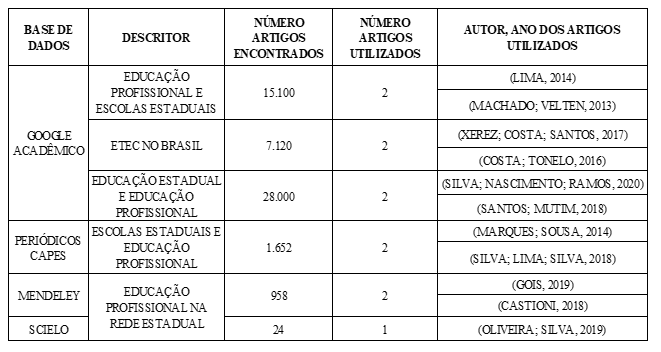
The results and conclusions of the articles on public policies for professional education in state public schools, with method, author and year of each article, appear in table 1.
The articles show that in the State of Ceará, public policies for professional education in state public schools enabled the expansion of EPT. This expansion resulted in an increase in the number of schools, vacancies offered and students enrolled in technical education. However, it did not reflect on the improvement of the quality of education that suffered from the lack of teachers in the technical area, the lack of adequate infrastructure for vocational education and qualification and/or continuing education for professionals working in EPT schools.
Table 1 Results and conclusions of articles on public policies for professional education in state public schools, with method, author and year of each article
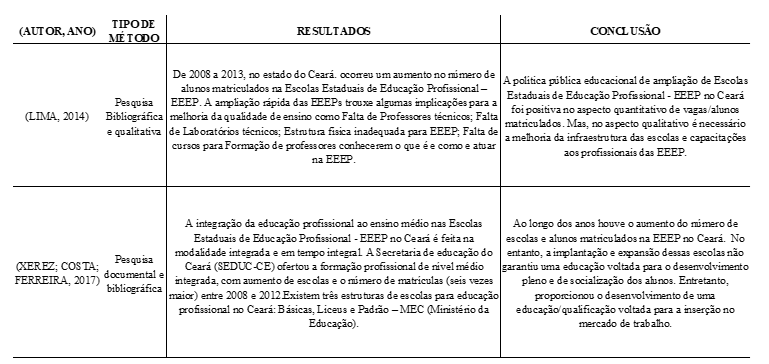
With the aim of qualifying high school students from the state network for the job market, the State of Ceará, with financial resources from the PBP (Professional Brazil Program), implements the EEEP (State Schools of Professional Education)[13], offering the Secondary education integrated with full-time Vocational Education. As it is a new teaching modality in the State, the demand for vacancies in this teaching modality was great. For this reason, and in fulfillment of one of the PBP objectives of expanding professional education in the country, it was necessary to expand, renovate and build schools to meet the demand (LEITE and ANDRADE, 2019; SANTOS, 2021).
From the launch of the PBP to the conclusion of the agreements between the MEC, the FNDE and the State of Ceará to implement the Integrated Plan of Professional and Technological Education of the State of Ceará (PIEPT)[14], only 08 months elapsed for the beginning of enrollments in the EEEP (RIBEIRO et al., 2020). It was necessary to build a new curriculum, with the proposal to offer comprehensive training to students, preparing them for the job market and for the full development of citizenship (MELO, 2021). In practice, however, it became evident that the interest in professional education had a marketing nature assumed by the public school in Ceará when adopting business parameters (RIBEIRO et al., 2020). And this was reflected in the quality of teaching. With the rapid implementation of the EEEP, there was no dialogue with the school community where the schools would be implemented. For example, which technical courses would you like to see implemented in schools; which technical courses the surroundings of that community would need to qualify as a workforce. In the teaching staff, it was noted the lack of effective teachers to meet the demand of schools, as well as teachers with technical-professional knowledge in the most varied disciplines belonging to the new curriculum matrix related to EPT. Also the precariousness of teachers’ work with the lack of adequate materials and training courses to understand what professional education is and how it works (CAVALCANTI and ANDRADE, 2021; RIBEIRO et al., 2022).
The implementation of EEEP in the state of Ceará was, then, marked by contradictions. While the government used financial resources from the PBP in the infrastructure of educational institutions, it did little or nothing in the pedagogical aspect, to ensure that the new curriculum matrix of the EEEP was organized and consistent with the reality of students, the community and labor market. As well as the lack of competitions for hiring teachers in the technical-professional area and the lack of investments in the continuing education of effective teachers, in order to guarantee the provision of a quality EPT (MACHADO and FERREIRA, 2020).
Articles on policies for the expansion of professional education in state public schools, containing the method, author and year of each article, as well as their results and conclusions are shown in table 2.
They show that the actions of public policies of Professional and Technological Education, such as the Professionalized Brazil and PRONATEC Programs of the Federal Government have in common the objective of expanding and expanding the EPT in the State Network. These programs contributed significantly to the increase in the number of creations/renovations of schools, the number of vacancies and the number of students enrolled in vocational technical courses in state schools in the country, thus fulfilling their objectives.
The Professionalized Brazil Program also has the purpose of financing EPT in the State Network of the Country and this action of distribution of financial resources ended up generating a financial dependence of the majority of the States.
Table 2 Results and conclusions of the articles on policies for the expansion of professional education in state public schools, with method, author, and year of each article
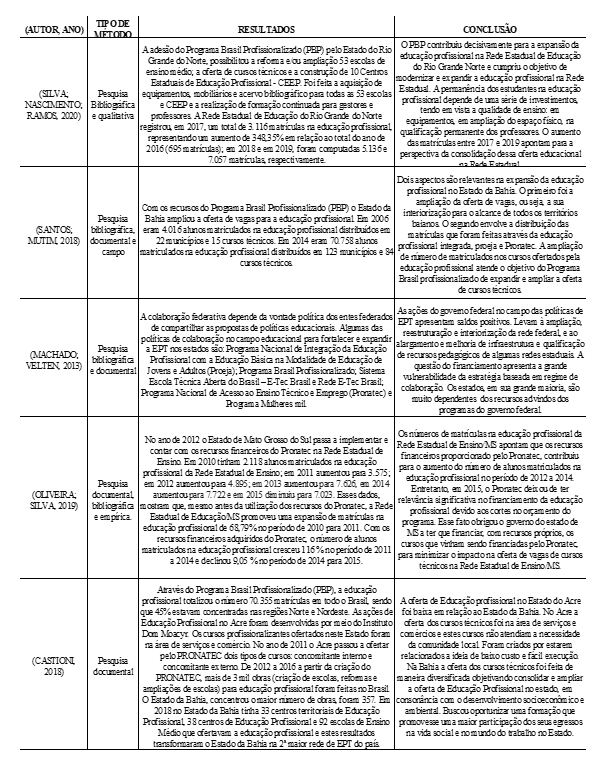
The Federal Government created programs, projects and actions of technical and financial assistance, aimed at expanding and strengthening the EPT and actions of public educational policies. The objective was to strengthen the country’s economic growth, overcome the lack of qualified labor and reduce the number of unemployed people. Among the programs, the PBP (Professionalized Brazil Program) and PRONATEC stand out. They were implemented in most Brazilian states, and reached the highest number of students enrolled during their executions (CARVALHO, 2019; MACHADO and FERREIRA, 2020).
As the PBP articulated secondary education with professional education in an integrated manner, and the possibility of full-time offer lasting 03 years (same duration of regular secondary education), the demand for this type of education grew. The students envisaged the possibility of finishing high school combined with a technical course, and thus entering the job market. PRONATEC articulated the offer of professional education through concurrent courses (take the regular secondary education at one school and the technical course at another), subsequent courses (for those who completed secondary education) and FIC courses (for those who had only completed elementary school or complete high school). These two programs were created as a way to guarantee the expansion and improvement of the quality of EPT in the state education network, promoting insertion/or permanence in the labor market (LIMA et al., 2018; MACHADO and FERREIRA, 2020; SILVA and MOURA, 2022).
The Brazilian states, in order to join and receive financial resources from the PBP (linked to the goals plan – everyone’s commitment to education) should, through a term of commitment, create a membership proposal with a detailed description of the pedagogical project, the budget , and the schedule of activities for the expansion and expansion of the EPT (BRASIL, 2007; MACHADO and FERREIRA, 2020).
Of the amount requested and approved in the PBP, 99% were passed on to state governments, which had to provide a counterpart of 1% of the resource. The resources provided by the PBP to the States do not have a strict inspection by the federal government to verify that they are being used for the intended purposes. This lack of inspection generated unfinished works and diversion of resources in some states (PAZOLINI and LIMA, 2021; SILVA and MOURA, 2022).
Table 3 shows the results and conclusions of the articles on different experiences of professional education in state public schools, with method, author and year of each article.
The differentiated experiences of professional education in state public schools become successful when a study is carried out, social and economic survey of the public that will receive the EPT. Like the state schools in the State of Paraná, which first investigated the public and the location to define which technical courses to offer to qualify the population and strengthen the economic development of the region.
At the State Technical School Center for Studies and Research in Municipal Administration – CEPAM in São Paulo, the technical courses offered aim at comprehensive human training, for full development in life in society and in the job market.
Table 3 Results and conclusions of articles on different experiences of professional education in state public schools, with method, author and year of each article
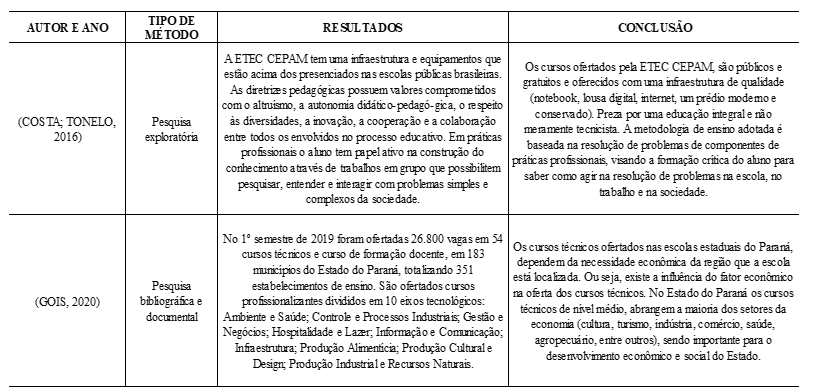
Professional and Technological Education (EPT) aims to qualify the workforce to serve the labor market and society (MEC, 2018c). To be successful, EPT training needs to be humanistic and integral to prepare critical, innovative, creative and socio-emotionally competent subjects (REGO et al., 2021; FERREIRA et al., 2022).
To form proactive students, a pedagogical practice that stimulates reflection, autonomy and creativity for the construction of knowledge is necessary. The student must be the builder and not just the receiver of knowledge. The classroom should be a space that encourages teaching and learning through activities that encourage perception, evaluation, reflection, creation and problem solving. The teacher has the role of being the intermediary of this learning process (SILVA et al., 2018b),
In the State of Paraná, the EPT was offered, articulating theoretical knowledge and practical knowledge, meeting the needs of the local economy, to supply the shortage and need for qualified labor, stimulating the protagonism of students through construction and not the mere transmission of knowledge (LOPES and DA SILVA, 2021).
At Centro Paula Souza in the State of São Paulo, the EPT curriculum is designed with pedagogical proposals that aim at teaching aimed at qualifying the workforce for the job market and at students’ cognitive, technological, cultural and artistic development. Teachers are trained to encourage students to develop skills and competencies in accordance with the vocational technical course in which they are inserted. In this sense, the teacher is considered a knowledge mediator, providing theoretical and practical knowledge, taking into account the experiences and potential of students (GUERRA, 2021).
Teachers who use differentiated educational methodologies, such as challenges and problem situations with content that make it possible to link theory with the practice of the future profession, are able to encourage active participation by students in classes. These pedagogical practices are considered motivating by the students as they make it possible to break with the conventional class (blackboard and brush), leading them to the development of critical and participatory thinking in class (SILVA et al., 2018b).
The results and conclusions of the articles on the role of the educational institution in professional education in state public schools, with the method, author and year of each article are shown in table 4.
The role of the educational institution in professional education in state public schools is to provide an omnilateral education that strengthens emancipation, autonomy, the development of intellectual, physical, emotional, social and cultural dimensions, in addition to preparing and qualifying for the job market.
Table 4 Results and conclusions of the articles on the role of the educational institution in professional education in state public schools, with method, author and year of each article

The creation of the Professionalized Brazil Program (PBP) took place at a time of economic growth in the country, aiming to stimulate the expansion of Professional Education in the state education network. It proposed a polytechnic education (linking high school to Professional Education), meeting the need to train qualified labor and prepare for the exercise of citizenship (PAZOLINI and LIMA, 2021).
Public Professional Education has the role of being free with an emancipatory and comprehensive training, and has as an educational practice the action of transforming the reality of students as workers and social agents. Therefore, it cannot be labeled as an education centered only on the training of labor for the labor market (CARVALHO, 2019).
The role of comprehensive training in Vocational Education schools is to encourage students to be participative, reflective, critical and autonomous beings. Comprehensive education means going beyond capital and the labor market, preparing students for life. It is to train students who can have autonomy over their personal and family life, who know how to undertake (building and generating income) and who have civic and social interaction (SILVA et al., 2018b).
CONCLUSIONS
The Federal Government, through programs, projects and actions of technical and financial assistance, invested in the expansion and expansion of the EPT. Most Brazilian states requested technical and financial assistance from the Federal Government to invest in EPT in their states. It was found that the Federal Government does not carry out an efficient inspection of the financial resources transferred to the States and this results in the misuse of these resources. Another situation is that the financing of Vocational Education derives mainly from financial resources from the Federal Government and not from the State, which sometimes implies the discontinuity of actions aimed at strengthening, expanding and expanding EPT in the states. There is also a lack of insertion of updated data by the State Secretariats of Education in the National Information System for Professional and Technological Education (SISTEC).
EPT cannot be described only as the development of skills and technical abilities to meet the demands of the job market. It goes beyond education for marketing purposes. EPT in the state network needs to be public, polytechnic and of high quality, capable of guaranteeing students insertion in the job market, in a perspective of emancipation and autonomy. It should be focused on comprehensive training with teaching methodologies that involve the active participation of students in the teaching and learning process, in which they are encouraged to develop and build critical thinking.
It is noteworthy that little is found about articles, publications that deal with EPT in the state network. It is necessary to have and carry out more studies and surveys in order to have a greater number of consolidated data about it, and thus increase the understanding of what EPT is like in state education networks in the country.
REFERENCES
BRASIL. Constituição da República Federativa do Brasil de 1988. Brasilia DF: Casa Civil 1988.
______. LEI Nº 9.394, DE 20 DE DEZEMBRO DE 1996 – Estabelece as diretrizes e bases da educação nacional. Brasília DF: Casa_Civil 1996.
______. DECRETO Nº 6.302, DE 12 DE DEZEMBRO DE 2007. Brasília DF, 2007. Disponível em: < http://www.planalto.gov.br/ccivil_03/_ato2007-2010/2007/decreto/d6302.htm >. Acesso em: 16 nov 2022.
______. LEI Nº 12.513, DE 26 DE OUTUBRO DE 2011. Brasília DF, 2011. Disponível em: < https://www.planalto.gov.br/ccivil_03/_ato2011-2014/2011/lei/l12513.htm >. Acesso em: 10 ago 2022.
CAPES. Treinamento no uso do Portal de Periódicos. Brasília DF, 2012. Disponível em: < https://www.fca.unesp.br/Home/Biblioteca/portal-capes.pdf >. Acesso em: 12 julho 2022.
CARVALHO, Á. B. D. Políticas Públicas para Educação Profissional no Brasil: Uma Análise Sobre a Concepção, Execução e Gestão do PRONATEC no Âmbito da Bolsa-Formação (2011-2018). 2019. 251p. (Doutorado). Universidade Federal de Sergipe, São Cristóvão SE.
CASTIONI, R. Programa Brasil Profissionalizado: A Oferta De Cursos Técnicos Na Bahia E No Acre. Revista Trabalho Necessário, v. 16, n. 30, p. 67-82, 2018.
CAVALCANTI, R. R.; ANDRADE, F. R. B. A Flexibilização Das Relações De Trabalho Docente No Ensino Médio Integrado À Educação Profissional Do Ceará: Uma Análise Sob A Ótica De Professores(As) Temporários(As) In: ANDRADE, F. R. B. e FERREIRA, H. P. (Ed.). Políticas de Ensino Médio e Educação Profissional: contextos, saberes e protagonismo no espaço escolar. Brasília DF: ANPAE, 2021. p.93-102.
COSTA, A. G.; TONELO, D. ETEC CEPAM: Modelo de ensino técnico nas áreas governamental e social no Brasil. Simetria, v. 1, n. 1, p. 32–40, 2016. Disponível em: < https://revista.tcm.sp.gov.br/simetria/article/view/89 >.
FERREIRA, R. B. et al. Competências socioemocionais em publicações em educação nos últimos cinco anos: uma breve revisão. Revista Científica Multidisciplinar Núcleo do Conhecimento, v. 4, p. 131-145, 2022. Disponível em: < https://www.nucleodoconhecimento.com.br/educacao/publicacoes-em-educacao >.
GOIS, E. H. D. B. Panorama Dos Cursos Profissionalizantes De Nível Médio Presencial Da Rede Estadual De Ensino Do Estado Do Paraná. Revista Brasileira da Educação Profissional e Tecnológica, v. 1, n. 18, p. 1-8, 2020. Disponível em: < https://www2.ifrn.edu.br/ojs/index.php/RBEPT/article/view/8818 >.
GUERRA, L. Perspectivas sobre inclusão no Centro Paula Souza: caminhos da arte para a educação básica e educação profissional tecnológica. In: PINTO, L.;PALINHOS, J., et al (Ed.). Arte Inclusiva? Quem Inclui Quem? Porto PT: CEAA/ESAP-CESAP, v.95-108, 2021.
IFSULDEMINAS. O que é o programa – Novos Caminhos. Pouso Alegre MG, 2022. Disponível em: < https://portal.ifsuldeminas.edu.br/index.php/pagina-fic-novos-caminhos/o-que-e-o-programa >. Acesso em: 12 set. 2022.
LEITE, M. C. D. S. R.; ANDRADE, F. R. B. ENSINO MÉDIO, EDUCAÇÃO PROFISSIONAL E PROGRAMA BRASIL PROFISSIONALIZADO: ANÁLISES E TENSÕES PÓS LEI 9394/1996. . e-Mosaicos Revista Multidisciplinar de Ensino, Pesquisa, Extensão e Cultura do Instituto de Aplicação Fernando Rodrigues da Silveira (CAp-UERJ), v. 8, n. 19, p. 132-146, 2019.
LIBÂNEO, J. C. Pedagogia e pedagogos, para quê? . São Paulo SP: Cortez, 2010. 107p.
LIMA, A. L. B. Escolas estaduais de educação profissional: a experiência de ensino médio integrado à educação profissional no Ceará a partir de 2008. 2014. 156p. (Mestrado Profissional). Universidade Federal de Juiz de Fora, Juiz de Fora MG.
LIMA, M. et al. PRONATEC: Para Que e Para Quem? HOLOS, v. 8, p. 183–201, 2018.
LOPES, H. A.; DA SILVA, A. L. Desafios Para A Implantação De Um Curso EPT/EJA Nno IFPR – Campus Umuarama. Educere et Educare, v. 16, n. 40, p. 83–110, 2021.
MACHADO, C. T.; FERREIRA, L. S. Políticas De Gestão E Financiamento Da Educação Profissional E Tecnológica No Brasil: uma análise das matrículas no Censo Escolar/INEP e a sua relação com os programas Brasil Profissionalizado e Pronatec. Plurais Revista Multidisciplinar, v. 4, n. 3, p. 93-113, 2020.
MACHADO, F. L. Censo escolar e Sistec: as mais importantes bases de coleta de dados para a EPT. Revista De Gestão E Avaliação Educacional, v. 1, n. 1, p. 1–8, 2019.
MACHADO, L. R. D. S.; VELTEN, M. J. Cooperação e colaboração federativas na educação profissional e tecnológica. Educação & Sociedade, v. 34, n. 125, p. 1113-1133 2013.
MARQUES, D. L.; SOUSA, A. D. A. A Proposta De Formação Das Escolas Estaduais De Educação Profissional No Ceará: Uma Análise À Luz Da Escola Unitária Gramsciana. Revista Labor, v. 1, n. 12, p. 88-108, 2014.
MEC. Guia PRONATEC de Cursos FIC. Brasília DF, 2016. Disponível em: < http://portal.mec.gov.br/index.php?option=com_docman&view=download&alias=41261-guia-pronatec-de-cursos-fic-2016-pdf&category_slug=maio-2016-pdf&Itemid=30192 >. Acesso em: 31 ago 2022.
______. PRONATEC. Brasília DF, 2018. Disponível em: < http://portal.mec.gov.br/pronatec >. Acesso em: 14 jul 2022.
______. Rede e-Tec Brasil. Brasília DF, 2018a. Disponível em: < http://portal.mec.gov.br/rede-e-tec-brasil >. Acesso em: 14 jul 2022.
______. Programa Brasil Profissionalizado. Brasília DF, 2018b. Disponível em: < http://portal.mec.gov.br/programa-brasil-profissionalizado >. Acesso em: 17 ago 2022.
______. Educação Profissional e Tecnológica (EPT). Brasília DF, 2018c. Disponível em: < http://portal.mec.gov.br/educacao-profissional-e-tecnologica-ept >. Acesso em: 23 nov 2022.
______. Novos Caminhos. Brasília DF, 2021. Disponível em: < https://www.gov.br/mec/pt-br/acesso-a-informacao/institucional/secretarias/secretaria-de-educacao-profissional/novos-caminhos >. Acesso em: 12 set. 2022.
______. CATÁLOGO NACIONAL DE CURSOS TÉCNICOS. Brasília DF: Ministério da Educação 2022.
MELO, M. A. D. A Proposta Pedagógica Das Escolas Estaduais De Educação Profissional do Estado Do Ceará, Sob A Ótica Dos Estudantes In: BEZERRA, F. R. e FERREIRA, H. P. (Ed.). Políticas de Ensino Médio e Educação Profissional: contextos, saberes e protagonismo no espaço escolar. Brasília DF: ANPAE, 2021. p.51-64.
OLIVEIRA, A. D. S., CELEIDA MARIA COSTA DE SOUZA. . A Meta 11 do PNE 2014-2024 e o Pronatec: resultados na Rede Estadual de Ensino de Mato Grosso do Sul (2012-2015). Interações, v. 20, n. 2, p. 357–368, 2019. Disponível em: < https://interacoesucdb.emnuvens.com.br/interacoes/article/view/1741 >.
PAZOLINI, M.; LIMA, M. Programa Brasil Profissionalizado no Espírito Santo: Cenário do Legado Para a Educação Profissional Estadual. Humanidades e inovações, v. 8, n. 53, p. 55-69, 2021.
REGO, F. A. D.; ROSAS, I. R. D. C.; PRADOS, R. M. N. Educação profissional e tecnológica como alternativa de acesso ao mercado de trabalho. Brazilian Journal of Development, v. 7, n. 2, p. 14585-14596, 2021. Disponível em: < https://www.brazilianjournals.com/index.php/BRJD/article/view/24536 >.
RIBEIRO, E. C. D. N. et al. Altas Habilidades no Ensino EPT e Regular: Uma Revisão dos Últimos Cinco Anos. Revista Científica Multidisciplinar Núcleo do Conhecimento, v. 4, p. 111-130, 2022. Disponível em: < https://www.nucleodoconhecimento.com.br/educacao/habilidades-no-ensino >.
RIBEIRO, E. C. D. S. et al. A Educação Profissional No Ceará Sob A Crítica Marxista: História, Política E Especificidades Revista e-Curriculum, v. 18, n. 2, p. 1809-3876, 2020.
SANTOS, A. O. C.; MUTIM, A. L. B. Educação profissional integrada na rede pública estadual da Bahia: a experiência do centro territorial da região Metropolitana de Salvador/BA. Revista Trabalho Necessário, v. 16, n. 30, p. 256-275, 2018.
SANTOS, M. S. F. D. Reflexões Sobre A Política De Educação Profissional E As Escolas Estaduais De Educação Profissional Do Ceará No Período De 2008 A 2020 In: ANDRADE, F. R. B. e FERREIRA, H. P. (Ed.). Políticas de Ensino Médio e Educação Profissional: contextos, saberes e protagonismo no espaço escolar. Brasília DF: ANPAE, 2021. p.38-50.
SEED. EDITAL Nº 01/2021 – PSS PROFESSOR NOVOS CAMINHOS TEC/FIC-SEED/AP. Macapá AP, 2021. Disponível em: < http://processoseletivo.ap.gov.br/download.php?arquivo=7011 >. Acesso em: 12 ago 2022.
SILVA, D. D. M.; MOURA, D. H. A implementação do Pronatec e as implicações na política de educação profissional: o prescrito e o efetivado. Educ. Pesqui., v. 48, p. 1-20, 2022.
SILVA, F. N.; LIMA, E. R. S.; SILVA, L. L. S. Cenários Históricos Da Oferta De Educação Profissional Pelo Brasil Profissionalizado Nas Escolas Estaduais De Mossoró/RN. Revista Brasileira da Educação Profissional e Tecnológica, v. 2, n. 15, p. 1-12, 2018. Disponível em: < https://www2.ifrn.edu.br/ojs/index.php/RBEPT/article/view/7276 >.
SILVA, F. N. D. et al. Financiamento da Educação Profissional e Tecnológica: Programa Brasil Profissionalizado. Revista LABOR, v. 2, n. 14, p. 120-133, 2015.
SILVA, J. M. N.; NASCIMENTO, S. M. N.; RAMOS, M. C. P. A Educação Profissional Na Rede Estadual Do Rio Grande Do Norte: Em Busca Da Consolidação. HOLOS, v. 4, p. 1–17, 2020. Disponível em: < https://www2.ifrn.edu.br/ojs/index.php/HOLOS/article/view/10053 >.
SILVA, R. F. D.; SOUZA, S. C. D.; LIMA, M. F. M. D. Papel Das Metodologias Ativas Na Formação Humana Integral Na Educação Profissional E Tecnológica. Educação Profissional e Tecnológica em Revista, v. 2, n. 2, p. 80-91, 2018b.
SISTEC. Consulta Pública das Escolas e Cursos Técnicos Regulares nos Sistemas de Ensino e Cadastradas no MEC. Brasília DF, 2022. Disponível em: < https://sistec.mec.gov.br/consultapublicaunidadeensino >. Acesso em: 30 ago 2022.
SOUZA, F. R. Relação entre a reforma do ensino médio e o programa novos caminhos: a retomada de velhas direções para a educação técnica no Brasil. Brazilian Journal of Development, v. 8, n. 5, p. 39866-39887, 2022.
SOUZA, V. A. D. O PRONATEC no sistema de ensino brasileiro: estudo de caso no Instituto Federal de Goiás, nos municípios de Goiânia e Aparecida de Goiânia. 2020. 140p. (Doutorado). Universidade Federal de Goiás, Goiânia GO.
VIANA, C. F. D. M.; CASTIONI, R. Programa Brasil Profissionalizado: coordenação federativa, formulação e implementação da política nacional de expansão das redes estaduais de educação profissional. Perspectivas em Políticas Públicas, v. 10, n. 19, p. 129-163, 2017.
VIANA, V. N.; DENDASCK, C. V.; DIAS, C. A. G. M. Valores e Atitudes. In: VIANA, V. N. e DIAS, C. A. G. M. (Ed.). Educação física e EPT. São Paulo: Centro de Pesquisa, v.1, 2020. cap. 3, p.24-36.
XEREZ, A. S. P.; COSTA, F. J. F.; SANTOS, J. D. G. D. Educação profissional integrada ao nível médio no Ceará: reformas e contradições. Educ. Form., v. 2, n. 4, p. 204–223, 2017. Disponível em: < https://revistas.uece.br/index.php/redufor/article/view/130 >.
APPENDIX – FOOTNOTE
6. Ministério da Educação e Cultura (MEC).
7. Sistema Nacional de Informação da Educação Profissional e Tecnológica (SISTEC).
8. Formação Inicial e Continuada (FIC).
9. Programa Nacional de Acesso ao Ensino Técnico e Emprego (PRONATEC).
10. Educação Profissional e Tecnológica (EPT).
11. Secretaria de Educação Profissional e Tecnológica (SETEC).
12. Catálogo Nacional de Cursos Técnicos (CNCT).
13. Escolas Estaduais de Educação Profissional (EEEP).
14. Plano Integrado de Educação Profissional e Tecnológica (PIEPT).
[1] Pedagogue, Philosopher, Professor and researcher at the Instituto de Ensino Básico, Técnico e Tecnológico do Amapá (IFAP), Student of the Programa de Pós-graduação em Educação Profissional e Tecnológica (PROFEPT IFAP).
[2] Biomedical, PhD in Tropical Diseases, Professor and researcher at the Campus Macapá Medicine Course, Universidade Federal do Amapá (UNIFAP), and at the Programa de Pós-graduação em Ciências da Saúde (PPGCS UNIFAP), Pro-Rector of Research and Postgraduate Graduation (PROPESPG) from the Universidade Federal do Amapá (UNIFAP).
[3] PhD in Psychology and Clinical Psychoanalysis. Doctorate in progress in Communication and Semiotics from the Pontifícia Universidade Católica de São Paulo (PUC/SP), Master’s Degree in Religious Sciences from Universidade Presbiteriana Mackenzie. Master in Clinical Psychoanalysis. Degree in Biological Sciences. Degree in Theology. He has been working with Scientific Methodology (Research Method) for more than 15 years in Scientific Production Guidance for Master’s and Doctoral Students. Specialist in Market Research and Health Research.
[4] Biologist, PhD in Tropical Diseases, Professor and researcher at the Physical Education Course at the Universidade Federal do Pará (UFPA).
[5] Biologist, PhD in Theory and Research of Behavior, Professor and researcher at the Instituto de Ensino Básico, Técnico e Tecnológico do Amapá (IFAP), the Programa de Pós Graduação em Educação Profissional e Tecnológica (PROFEPT IFAP) and the Programa de Pós Graduação em Biodiversidade e Biotecnologia da Rede BIONORTE (PPG-BIONORTE), Amapá hub.
Sent: December, 2022.
Approved: December, 2022.















